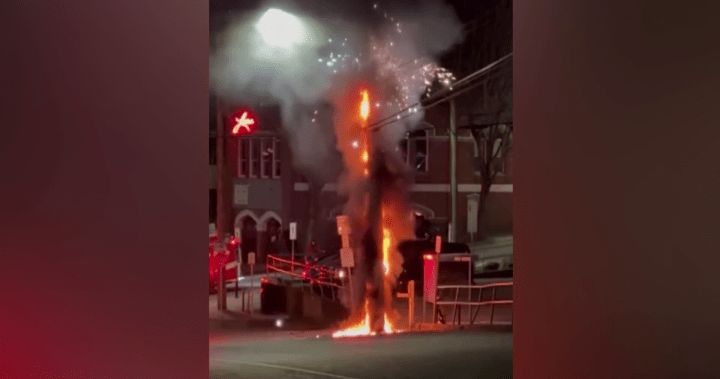A remote landslide in B.C.’s Central Interior that’s blocking a river is still being closely monitored.
On Saturday afternoon, the province issued an update, saying the Chilcotin River landslide is still seeing activity as some debris continues to tumble down.
The government said this is expected, considering Wednesday’s landslide is still relatively new.
Located around 100 km southwest of Williams Lake, the dam is estimated to be 1,000 metres in length, 100 metres high and 30 metres in depth.
It also said the sudden lake from pooling water behind the dam is continuing to grow at a rate of 22 cm per hour.
Officials also discussed worst- and best-case scenarios.
In the worst-case scenario, water breaches the top of the dam, with the dam then failing one hour later.
The rush of water would be instant and stunning, with the Chilcotin River rising around 10 metres.
A typical freshet flow during spring runoff in the Chilcotin River is around 300 cubic metres per second. In this case, that would incredulously spike to 6,500 cubic metres per second.
Officials say it would take that water three hours to rush down the Chilcotin River and into the Fraser River, where it empties.
At that confluence, this scenario would see water rush into the Fraser at around 5,500 cubic metres per second. That equates to peak height being around four metres higher above their current elevation.
Downstream at Lillooet, which would take 15 hours to reach, the peak height would be around 1.8 metres above water levels now. The flow there would be around 2,650 cubic metres per second.
“The good news is that once we hit the Fraser River, this water and material has a significant amount of room to spread out and disperse,” said Connie Chapman, who is with B.C.’s water management branch.
Breaking news from Canada and around the world
sent to your email, as it happens.

Get breaking National news
For news impacting Canada and around the world, sign up for breaking news alerts delivered directly to you when they happen.
“To put this in context, during a typical freshet year (at Lillooet), we see 5,400 cubic metres per second.”
At Hope, 29 hours later, the water height would be a 30-cm increase.
In the best-case scenario, water will breach the top, then take 24 hours to slowly cut a channel through the dam.
At the confluence of the Chilcotin and Fraser, the river would only rise 2.1 metres above normal. And at Lillooet, it would be under a metre in height.
However, officials warned that these are models with assumptions, and, regardless if they’re right or wrong, rushing water is very dangerous, no matter how high or low it is.
“This really does give us a starting point to understand where we may be headed,” said Chapman, adding the province has confidence this will be an over-the-top breach failure versus a seepage failure.
“As we continue to collect data, we will be able to refine these numbers to give the best estimate we have.”
“The modelling now suggests that even under those worst-case scenarios of a significant breach happening quite quickly, water levels in the Fraser River might be only slightly higher than what we would expect during a typical snowmelt season,” said Nathan Cullen, Minister of Water, Land and Resource Stewardship.
He added that while the Chilcotin River faces real risk, “we are not letting our guard down, even for a second with regards to this issue. We continue to actively monitor the situation and are preparing for all possibilities.
“There are still risks, including further landslides upstream of the dam and potential slides downstream once the water starts to flow through in a significant way.”
Cullen also said it’s extremely important for residents to obey emergency orders and to stay away from the banks of the Chilcotin and Fraser rivers.
“We are also taking very seriously the potential impact of this slide on wild salmon and other fish species,” he said, adding that the majority of this year’s chinook salmon run is past the landslide area.
“We are also estimating that we should have four to seven days to plan for returning sockeye salmon as they work their way up the Fraser to the Chilcotin.”
Bowinn Ma, the Minister of Emergency Management and Climate Readiness, called it “an encouraging development for communities downstream.”
“But we nevertheless continue to coordinate closely with communities along the rivers to ensure that we’re prepared to protect people from potential flooding.”
© 2024 Global News, a division of Corus Entertainment Inc.




